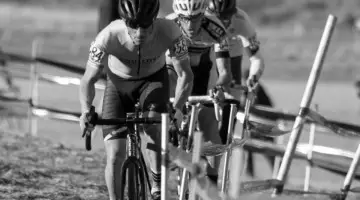Last Monday, Adam Myerson examined tire and pressure choices for cyclocross conditions. Today, he goes back to the technique side of things, and looks at incorporating a run into cyclocross. While many riders out there might scoff at the idea of training to run on courses that are becoming more ride-heavy, you never know what conditions you will encounter, and sometimes, being fresh for a run can mean seconds gained when back on the bike.
You can find other training ideas and articles at cycle-smart.com, as well as information on internationally-recognized coaching and clinic programs for all skill levels.
by Adam Myerson
Like riding barriers or navigating through mud, running is one of those core qualities of cyclocross that isn’t the most important aspect or even mandatory, but crucial to be prepared for. Cyclocross is still mostly about who can pedal their bike the fastest, and while a race might be lost on the run, they’re only occasionally won there. Some of us may have a little more natural talent for it, or even a running or triathlon background, but running when you’ve spent a season racing road or mountain bikes just plain hurts. As you prepare for the cyclocross season, it’s important to first be able to incorporate adaptive running into your training, and then actually be able to do some structured work to improve your running performance, if possible. Cyclocross is painful enough, but by focusing on running in your training you can remove a weakness, or further your advantage if that’s where you’re already strong.
The first step in your running program should be to determine when you think you can begin to include it as part of your training. Ideally, you don’t want to begin until after your last important road or mountain bike event of the year. A mountain bike racer might be able to handle it a bit sooner, and may even include running as part of their plan already. But for a road rider, nothing will kill your road fitness worse that running, so wait as long as you can. If ‘cross is your specialty and your primary focus, as it is now for many of us, then you can begin running as soon as you start your base period for the season during the summer.
The initial running workouts for all riders should revolve around adaptive work to be able to handle the movement of running. Start with short, 15-minute jogs at a very low intensity one to two times a week, just to get your body used to the mechanics. When you can finish 15 minutes of jogging with no DOMS (Delayed Onset Muscle Soreness) the next day, you’re ready to handle a larger and more intense workload. That might take only a week, or as long as a month. Always wait until the soreness subsides before you undertake another running workout.
Once riders begin to add running training, a mistake many make is to go for long, extended runs. In ‘cross, as with any sport, you have to be specific, and that applies to your running training, too. Take a look at the length of time you’re typically on foot in a ‘cross race. Normally it’s for stretches where you’re at maximum intensity for about 15 seconds or so, over barriers or up a short run. The longest a run should be in a well-designed ‘cross course is 80 meters. So in any case, you are very rarely running for more than a minute at a time, and most often, for much less than that.
When you’re ready to introduce some real running work, there are a number of different ways to do it. Again, because you should be emphasizing short bursts as your first priority, much of your running can take the form of a traditional sprint workout. Find a steep hill, ideally off-road, that takes you 10-15 seconds to sprint up. Structure the workout just as I’ve described in previous articles: 100% effort, from rest, with the sprints being no closer than one every two minutes, with one every five being ideal. How many you do will depend on how many quality efforts you’re able to complete. You should consider your average ’cross race: how many laps is normal, and how many runs per lap? If you have two decent runs in a race that will be about 10 laps, then you should be prepared to build up to 15-20 solid sprinting efforts in your workout.
You can do this as its own workout without your bike, where you simply jog at a light intensity to your sprinting spot and jog home. This is definitely a good approach for people squeezing workouts in before or after dark. You can also do it as part of a ’cross ride where you do your warm up on the bike, and then include a dismount and mount as part of your sprinting effort. If your technique is good and you want to isolate the specific fitness aspect of the sprint, then you might choose the former approach. If you feel you need work on your skills and ability to run well with the bike on your shoulder, choose the latter. Again, in the name of specificity, the latter should be your first choice, if possible.
There are courses or regions where you’ll find yourself dealing with longer, extended runs, and the 15-second efforts aren’t enough to prepare you for all your races. Certainly, this is one of the few times where there’s an actual difference between racing in Europe and racing in North America. If you know you have to prepare for running-heavy races where the running is more steady-state and extended, rather than a sprint, this is where you might try to include more running as part of your training on a threshold or VO2max workout day. If you’re doing a ‘cross-specific workout on a local course or with a small group session, you can try to incorporate a longer, up to minute-long run as part of your course. You might also decide to do a separate running workout where you designate some of your threshold or VO2max work to be done on foot. 5-15 minute long efforts at race pace is a good way to improve on the longer runs.
Another angle on your running training for ‘cross is to use it as a substitute workout on those short daylight days where you find yourself getting out to train after dark. While again, long running days shouldn’t be your first choice, if the trainer’s lost its charm and you’re pressed for time and daylight, converting your riding intervals to a running workout can help you solve two problems at once. Sprint and threshold workouts are definitely the best days for this. Focus on the intensity rather than the duration; get the intervals done, but don’t worry about hitting the total time you might have done if you were out on the bike.
There are many different ways to approach running for cyclocross. Your training might vary from 2-4 days per week with at least a short jog, to the other extreme of only running during races. What you decide should be based on the time you have available to add a running workout, if it’s a strength or weakness you want to emphasize, or if the courses you race on require that you improve your performance in that area. You might find that a little more focus on your running is a small investment with big returns, and turns a place you once suffered into a place you can attack.





























